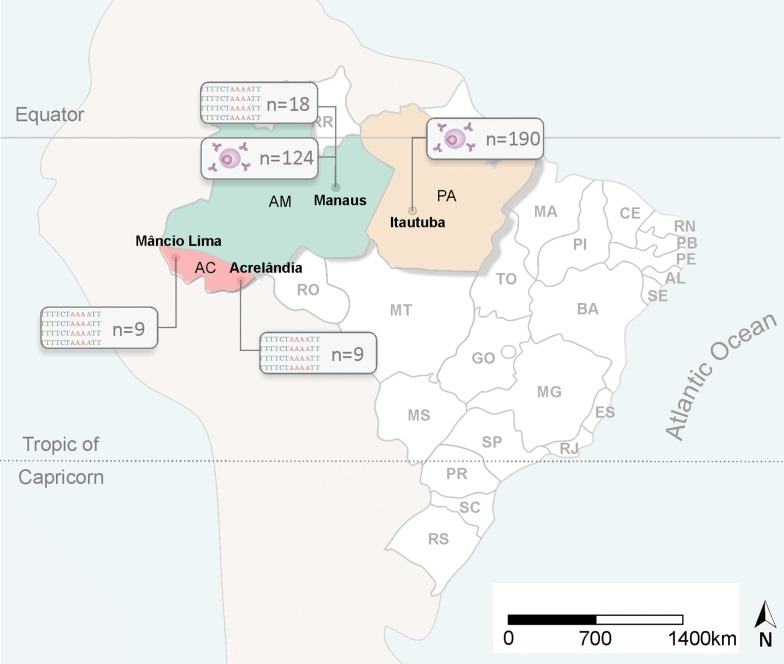Genetic sequence characterization and naturally acquired immune response to Plasmodium vivax Rhoptry Neck Protein 2 (PvRON2).
The genetic diversity of malaria antigens often results in allele variant-specific immunity, imposing a great challenge to vaccine development. Rhoptry Neck Protein 2 (PvRON2) is a blood-stage antigen that plays a key role during the erythrocyte invasion of Plasmodium vivax. This study investigates the genetic diversity of PvRON2 and the naturally acquired immune response to P. vivax isolates. Here, the genetic diversity of PvRON2 1828-2080 and the naturally acquired humoral immune response against PvRON2 1828-2080 in infected and non-infected individuals from a vivax malaria endemic area in Brazil was reported. The diversity analysis of PvRON2 1828-2080 revealed that the protein is conserved in isolates in Brazil and worldwide. A total of 18 (19%) patients had IgG antibodies to PvRON2 1828-2080 . Additionally, the analysis of the antibody response in individuals who were not acutely infected with malaria, but had been infected with malaria in the past indicated that 32 patients (33%) exhibited an IgG immune response against PvRON2. PvRON2 was conserved among the studied isolates. The presence of naturally acquired antibodies to this protein in the absence of the disease suggests that PvRON2 induces a long-term antibody response. These results indicate that PvRON2 is a potential malaria vaccine candidate.
Authors
Najara C Bittencourt; Juliana A Leite; Ana Beatriz I E Silva; Tamirys S Pimenta; João Luiz Silva-Filho; Gustavo C Cassiano; Stefanie C P Lopes; Joao C K Dos-Santos; Catarina Bourgard; Helder I Nakaya; Ana Maria Revorêdo da Silva Ventura; Marcus V G Lacerda; Marcelo U Ferreira; Ricardo L D Machado; Letusa Albrecht; Fabio T M Costa
External link
Publication Year
Publication Journal
Associeted Project
Microbiology or Immunology
Lista de serviços
-
Genomic analyses reveal broad impact of miR-137 on genes associated with malignant transformation and neuronal differentiation in glioblastoma cells.Genomic analyses reveal broad impact of miR-137 on genes associated with malignant transformation and neuronal differentiation in glioblastoma cells.
-
RNA-Binding Protein Musashi1 Is a Central Regulator of Adhesion Pathways in Glioblastoma.RNA-Binding Protein Musashi1 Is a Central Regulator of Adhesion Pathways in Glioblastoma.
-
MicroRNA Transcriptome Profiling in Heart of Trypanosoma cruzi-Infected Mice: Parasitological and Cardiological Outcomes.MicroRNA Transcriptome Profiling in Heart of Trypanosoma cruzi-Infected Mice: Parasitological and Cardiological Outcomes.
-
Genome mapping and expression analyses of human intronic noncoding RNAs reveal tissue-specific patterns and enrichment in genes related to regulation of transcription.Genome mapping and expression analyses of human intronic noncoding RNAs reveal tissue-specific patterns and enrichment in genes related to regulation of transcription.
-
Antimicrobial peptide LL-37 participates in the transcriptional regulation of melanoma cells.Antimicrobial peptide LL-37 participates in the transcriptional regulation of melanoma cells.
-
Down-regulation of 14q32-encoded miRNAs and tumor suppressor role for miR-654-3p in papillary thyroid cancer.Down-regulation of 14q32-encoded miRNAs and tumor suppressor role for miR-654-3p in papillary thyroid cancer.
-
Integration of miRNA and gene expression profiles suggest a role for miRNAs in the pathobiological processes of acute Trypanosoma cruzi infection.Integration of miRNA and gene expression profiles suggest a role for miRNAs in the pathobiological processes of acute Trypanosoma cruzi infection.
-
Integrative Biology Approaches Applied to Human DiseasesIntegrative Biology Approaches Applied to Human Diseases
-
Proteomics reveals disturbances in the immune response and energy metabolism of monocytes from patients with septic shock.Proteomics reveals disturbances in the immune response and energy metabolism of monocytes from patients with septic shock.
-
Genomics, epigenomics and pharmacogenomics of Familial Hypercholesterolemia (FHBGEP): A study protocol.Genomics, epigenomics and pharmacogenomics of Familial Hypercholesterolemia (FHBGEP): A study protocol.
-
Melatonin-Index as a biomarker for predicting the distribution of presymptomatic and asymptomatic SARS-CoV-2 carriersMelatonin-Index as a biomarker for predicting the distribution of presymptomatic and asymptomatic SARS-CoV-2 carriers
-
Profiling plasma-extracellular vesicle proteins and microRNAs in diabetes onset in middle-aged male participants in the ELSA-Brasil study.Profiling plasma-extracellular vesicle proteins and microRNAs in diabetes onset in middle-aged male participants in the ELSA-Brasil study.
-
Big Data and machine learning in cancer theranosticsBig Data and machine learning in cancer theranostics
-
Genomic positional conservation identifies topological anchor point RNAs linked to developmental loci.Genomic positional conservation identifies topological anchor point RNAs linked to developmental loci.
-
Integrative systems immunology uncovers molecular networks of the cell cycle that stratify COVID-19 severityIntegrative systems immunology uncovers molecular networks of the cell cycle that stratify COVID-19 severity

